- Home
- Timothy Egan
Lasso the Wind: Away to the New West Page 4
Lasso the Wind: Away to the New West Read online
Page 4
THE ROAD to the Diamond Bar goes north into the heart of the Gila. I take a detour to the west, following the slow, climbing way up a canyon along a fork of the river to a dead end near the base of the old Mogollon village. The country is wild and open, with thick stands of pine and cottonwood growing in the drainage. A wind from the north whistles through, and there’s a dusting of snow from a few days ago left in the shadowed pockets. I walk toward the ruin, high above the canyon, where dwellings are sculpted into the cliffs. The light is catching it just right, so it looks sandblasted white. These Mogollon people disappeared around the year 1290, but you can almost see their fingerprints and smell their camp-fires. The original timbers between stacked rocks are polished, somewhat cracked, but solid. The walls are in place, built with stone quarried from the neighboring cliffs. There are about forty rooms. I hike up one of the ladders, find a comfortable sitting room in a Flintstone condo, and look back down to the canyon.
These cliff dwellings were perhaps the last homes of the Mogollon before they scattered. They had lived in the Gila region since 200 B.C., growing corn and hunting jackrabbits, pronghorn, gophers, deer, and mountain sheep. At first, their pottery was simple, the red-earth clay bowls and pitchers of day-to-day living. As time went on, they built bigger villages, above-ground pueblos, and figured out a way to store walnuts, cacti, squash, kidney beans, piñon nuts, and other foods for years. And then came an electric leap in creativity. About the year A.D. 900, the start of the Mimbres Classic period, the Mogollon began painting black-on-white geometrical designs on their pottery, an influence perhaps of the Anasazi, with whom they traded. One of their most striking works is a bowl that seems to represent Halley’s Comet, which made an appearance in 1066. They sketched birds with human faces, scrolls and rectangles zigging and zagging into mathematical infinity, quails, turkeys, lizards, ducks, and rabbits painted in black from brushes made of yucca leaves. Fish and frogs—now mostly gone from the Gila—show up everywhere, riding on the backs of men, kissing women. There were mythic monsters and lusty humans. It all had a vitality to it, a sense of good times and exuberant spirituality—“an expression of the sheer ecstasy of living,” as the archaeologist Paul S. Martin has written.
And it didn’t stop there. Some of the best stuff was buried with the dead. Typically, a body was laid to rest with the knees up near the chest—as if preparing to spring out somewhere at a later date. A bowl in full Mimbres flourish was placed over the head of the deceased, with a “kill hole” no bigger than a quarter punched in the center to allow the spirit to escape to the other side. For more than a thousand years, the Mogollon prospered in these parched mountain valleys, growing crops in an area that received just nine to twenty inches of rain a year, with only about a hundred days between the last frost of spring and first subfreezing day of late summer. The Mogollon are never mentioned in Catron County’s custom-and-culture laws. But Teddy Roosevelt, the asthmatic who got his second wind in the dry air of the West, set aside 533 acres here in the heart of the thousand-year-old ghost town, as the Gila Cliff Dwellings National Monument in 1907.
I MAKE it to the Diamond Bar Ranch without a shot being fired at me, but now I’m scared. A fly rod is no match for a shotgun. The road into Kit Laney’s territorial perch narrows and enters a country of mud, low clouds, and foreboding. The grass has not come up yet, but some meadows look matted over. The streams, the life-giving arteries of the Gila River, have eroded banks, tromped by cattle hoofprints. It’s very cold. Willows and cottonwoods, which hold the streambanks together, are chewed to bits; their bare roots trail away, clinging to bits of soil around boulders. I don’t see any cattle, though; they have been moved, possibly to avoid seizure by the Forest Service.
At last, I find Laney. Cowboys aren’t my weakness, but Kit Laney and his wife, Sherri, are about as nice as any young Mormon couple you might find politely proselytizing the tourists in Temple Square—except that they are heavily armed. Laney tells me he’s just trying to do what folks in his family have always done—scratch a living from the wild country of the Gila River drainage. He spends most of his time on a horse; the Laneys own two dozen of them. They live in a little place without electricity. He hauls water and cuts wood for the stove. They raise pigs, milk cows, and make their own butter and bacon. They have a big garden in the summer. Sherri makes horse saddles. Preferring to live like Jeremiah Johnson instead of Tim Allen, they shun the new Wal-Mart down in Silver City and weave their own clothes. They live off game, beef, and canned vegetables. Their grocery bill for an entire year, Laney says after warming up to me, is just over a thousand dollars.
“I’m fourth-generation Catron County, so’s Sherri,” he says. “We were both born here.”
Laney’s great-grandfather came to the county in 1883, a Mormon pioneer from Utah, pushing the southern frontier of the planned state of Deseret. Sherri is from a ranching family to the north. They bought the ranch—a small bit of private land and the permit allowing them to graze cattle on a huge swath of public land—in 1986, when beef prices were relatively good. At the time, the Laney’s were a newlywed pair of twenty-three-year-olds, green but ready for saddle sores and palm blisters. Each of them had fantasized about owning a big ranch. Laney expected to run nearly twelve hundred head of cattle a year over the Gila National Forest. When he acquired the ranch, he says, the Forest Service assured him that grazing such a large herd would be okay, as long as he kept his beasts out of the streams that form the Gila. Laney made plans to build fifteen big water-holding tanks in the national forest, a place for his cattle to drink. And then he took out a bank loan, a half-million-dollar note on the Black Diamond allotment.
As it turns out, the world has plenty of cheap meat. Cattle feedlots are stuffed with steroid-pumped, ready-to-slaughter-and-wrap beef that can find its way into a hamburger bun much quicker and cheaper than anything a lone cowboy in southern New Mexico can do. The nineteenth-century wish of army general Phil Sheridan has come true. “Let them kill, skin and sell until the buffalo are exterminated,” he said. “Then your prairies can be covered with speckled cattle and the festive cowboy.” Laney’s cows may be speckled, but he has nothing to be festive about. People are eating less meat, afraid of E. colt or high fat or, more recently, mad-cow disease. In the mid-1990s, beef prices tumbled. The price for a big steer went from nearly a dollar a pound to eighty cents, then down to sixty cents. Laney is not running a fantasy ranch. He needs cash to pay off the bank loan.
“Nobody’s getting rich off this,” says Laney. “But I’ll tell you this: all the gold in Fort Knox would not get me to change my life.”
He paused for a good long cowboy minute. “Yes, sir,” he said. “I am the richest man in the world.”
He works twelve hours a day, with some of the world’s stupidest animals, placed in an environment that is foreign to their native ground. He might as well be raising chickens in Rockefeller Center. The problem, for Laney, is that the land he wants for cattle feed is owned by every American. Some of those shareholders don’t like the mashed-out streams, the trails of cow turds, the bellowing Herefords in a place where they expect to hear bugling elk. They have been complaining to the Forest Service, which has done study after study about how cattle are ripping up the wilderness of the Gila. Eventually the Service asked Laney to reduce his cattle herd. He was furious. He sought help from the major cattle organizations, and Senator Pete Domenici, New Mexico’s senior legislator. Then Catron County passed its custom-and-culture laws, giving Laney a legal justification for his defiance. But it couldn’t bring beef prices up.
The way Laney figures it, he owns the right to use the water that runs through the section of the Gila where the cattle graze. If the government wants water to keep the public forest alive, they will have to pay him for it. “I’m saying to the Forest Service, You guys don’t own this water.’ And they may not even own the land. They never have been able to produce a title document.”
And his cattle, he says, are part of the custo
m and culture of the region; thus, any attempt to reduce the numbers would violate the law. The Forest Service, after hearing from Senator Domenici, retreated. But then, not long before I hooked up with Laney, they reversed themselves. Too many other species of the forest were dying because of sloppy grazing practices. They told Laney to reduce his cattle herd by more than half in order to rest the land. They also decided he couldn’t build the water-holding tanks, saying the big impoundments didn’t belong in the wilderness of a national forest.
“That will bankrupt me,” says Laney. “You can bet your life on it.”
So he is free from bureaucratic entanglement, and he’s also an outlaw. “Yes, sir, I guess some people might look at it that way,” he says. “We have been told that we are in trespass. We have not paid grazing fees. So … will I have to shoot the next son of a bitch who tells me to move my cattle?”
I give him my own cowboy minute of silence.
“I can’t tell you what’s going to happen. But if they succeed in kicking us out of here, you will lose the custom and culture of three counties. Just like that, it’ll disappear.”
I HAVE no use for my fly rod in these arthritic woods in the Border Country. The Gila trout, a big fighter, weighing up to two pounds, the subject of many a fish tale among old-timers, is nearly extinct. You would think that one of the largest perennial streams in the American Southwest, brought to life by a wilderness holding deep snows in its higher reaches, would be full of life. But the Gila River is all but dead. And so is the forest. Much of it looks devastated. There used to be wolves, grizzly bears, Merriam’s elk, beavers, black-footed ferrets, and river otters here. Most of them exist, now, only on the cracked pottery of the long-vanished Mogollon.
But there are plenty of cows. And a young couple, earnest and honest, backed by a local ordinance that proclaims them the end line of Western custom and culture, and supported by a United States senator with a strong grip on the entire federal budget, stand ready to die for those cattle that nobody wants. The great irony of this is that these cows, this sick forest, are all part of a land that was supposed to be a model for how the West could make peace with itself. The wilderness culture of the West started here. Most of Kit Laney’s cows run through a part of the national forest called the Aldo Leopold Wilderness—Americas first formal wilderness, a huge swath of land that was set aside for all time, designated as a place “where man himself is but a visitor.”
Leopold came to Catron County in 1909, a pioneer Forest Ranger touched by the big, sweet-smelling ponderosa pines at eight thousand feet, the eagles snatching fish from the Gila River, the hardscrabble hunters who came to these mountains for meat and could spend more than two weeks looking to get off one shot at an elk that might feed the family. “Think like a mountain,” Leopold used to tell his fellow rangers. He developed many of his ideas while living in Catron County, roaming on horseback in Smokey’s uniform over the same country where Laney runs his cattle. Once, in a famous epiphany, he killed a wolf and watched as “the fierce green fire” drained from the animal’s eyes. He was a Forest Service employee for fifteen years. During that time, the early age of the touring automobile, he saw many roads built into places that used to be the exclusive haunt of horse or human hoof. He saw all but three of the thirty mountain watersheds on public land in the Southwest nearly destroyed by overgrazing. “We abuse land because we regard it as a commodity belonging to us,” Leopold wrote later. “When we see land as a community to which we belong, we may begin to use it with love and respect.”
In the early 1920s, about ten years before he wrote The Sand County Almanac, a book that would make Leopold a household name around the world (his book has just been given its first printing in China), he came up with the idea of keeping some part of the Gila in its wild state, protected by law. He envisioned a place “big enough to absorb a two weeks’ pack trip, and devoid of roads, artificial trails, cottages, and other works of man.”
Congress approved. It was the first time that any country in the world set aside an area, not as a playground like Yellowstone, or a freak show of nature like Devil’s Tower, but simply for the sake of its wildness. It is one of many reasons why Leopold belongs on the Mount Rushmore of American conservation, along with Teddy Roosevelt, John Muir, and Rachel Carson.
Leopold died in 1948. A few months before I saw Laney, one of Leopold’s sons, Luna Leopold, came back to the wilderness named for his father. He was appalled by what he saw: the cow-mashed streams, the overgrazed meadows, the dying trees, a technicolor land fading to black and white.
“My father would be shocked if he were here today,” said Leopold.
I ask Laney about Aldo Leopold and whether a bunch of cows descended from British stock should be able to run wild through what is supposed to be a slice of original America.
“No. Cows don’t belong here.”
I’m not sure I heard him right.
“That’s what I said. Ill be honest with you: wilderness and cattle can never coexist. Wilderness areas are supposed to be, as the law says, untrammeled by man. There is no doubt that cattle have had a huge impact. Nine times out of ten, backpackers run into our cattle. And that’s not what a wilderness is supposed to be.”
Still, Laney won’t budge. He has cornered himself and can imagine no other life. The Mogollon lived for better than a thousand years in the slightly watered valleys here, but Kit and Sherri Laney cannot make a living on their nearly 150,000 acres.
“Cowboys are like bears and mountain lions,” the Border Country poet Drum Hadley, a rancher himself, has said. “They need a certain range, a certain critical mass of land, on which to exist.”
THERE IS another huge spread in south-central New Mexico, bigger than the Diamond Bar. The Armendaris Ranch is owned by Ted Turner, the man who founded CNN, and has become a land-rich padrone, with more than a million acres in New Mexico. He has replaced cattle with bison, brought in wolves, bighorn sheep, prairie dogs, and a few other animals that have long been missing. Turner might bring in rattlesnakes, he says, if he finds that they are endangered. To the people who make the rules in Catron County, Turner is the wacko. He sees himself as a modern-day Noah, after the landing, trying to restore the world. Turner doesn’t get a dime in government subsidies. But his bison, when he sends them to market, are bringing in more than three times what cattle get, and they tend to stay out of the streams as well. He has more than two thousand of the big shaggy-headed ungulates on his ranch, defying the injunction of General Sheridan. In the few years since he decided to play Old Testament rancher, bison prices have tripled. The meat is sweeter than beef, with low cholesterol. Turner in a way may be to twenty-first-century New Mexico what James Catron was to the nineteenth century. He owns more than a thousand square miles of New Mexico—1.5 percent of the state. So how does a billionaire gentleman bison rancher cable television magnate fit into the custom and culture of the West?
THE CENSUS of 1870 reported that most of the women who worked in the West were classified as “domestic servants” and “hotel employees”—both euphemisms for prostitutes. The Civil War took the lives of 850,000 men, leaving an army of widows, many of them impoverished. For those who made their way West, and could not find a husband-farmer, there were jobs in brothels or saloons, or as “night workers” in hotels. It is likely, some historians argue, that for a decade or more the prostitute was the archetypal Western woman. But it is one thing to kill and become a legend, another to whore. Wyatt Earp, after shooting up a rival gang in Tombstone, went to Hollywood and lived off his creation. The woman he introduced around Tombstone as his wife, Mattie Blaylock, became a prostitute and later died of a drug overdose. But suppose she and others in the sex trade had taken the cowboy path to mythic elevation. Would prostitutes then have a claim on the custom-and-culture statutes? Would people be celebrating Wild Whore Days in Silver City?
The Indian chief Geronimo lived in Catron County for a while, in hiding, taking his restorative soaks in Gila Hot Springs. His
“war” amounted to three dozen men trying to dodge five thousand soldiers. The last years of his life read like a cautionary tale against Indian assimilation policies of the time. He joined the Dutch Reformed Church, then got drunk one night, fell off a wagon, and died. Confederate deserters also found a refuge here. And so did Dave Foreman, the founder of Earth First!
This is a land of Latinos and Leopold, psychotic: gunmen and radical vegetarians, beltway cowboys and billionaire environmentalists. Ranching is just one of the things people did to make a living.
Even so, running cattle on dry, broken public land in the arid West may still become a sacred right, protected from change itself. Some members of Congress have vowed to pass a bill that would essentially do the same thing to 300 million acres of public land as Catron County has tried to do in its backyard. Cattle-grazing would be preserved, by law, as the dominant use of land owned by every American. Outside of a few thousand people who hold leases to this land, nobody would have any real say over how the land would be utilized or managed. They could call their bill the Cowboy Preservation Act. But then prostitutes in Nevada, heirs to an old Western way, might ask for similar protection. Or 7–11 holdup artists harking back to Billy the Kids ties to the land, backed by the folks who stage those Saturday morning gun-fights in old-town Albuquerque, will seek a sanctuary for themselves. Or descendants of Spanish land-grant holders, legally robbed by the founding father of Catron County, could ask for congressional protection. Each has a claim on the West.

 The Immortal Irishman
The Immortal Irishman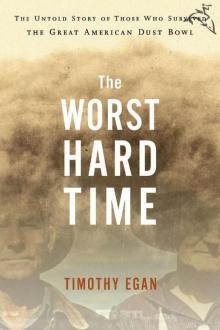 The Worst Hard Time: The Untold Story of Those Who Survived the Great American Dust Bowl
The Worst Hard Time: The Untold Story of Those Who Survived the Great American Dust Bowl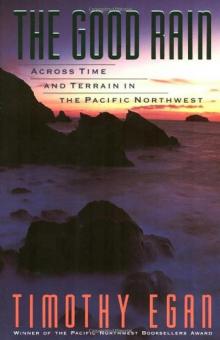 The Good Rain: Across Time & Terrain in the Pacific Northwest
The Good Rain: Across Time & Terrain in the Pacific Northwest Breaking Blue
Breaking Blue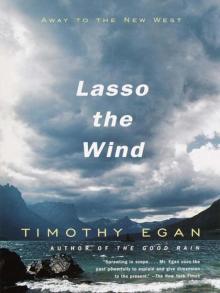 Lasso the Wind: Away to the New West
Lasso the Wind: Away to the New West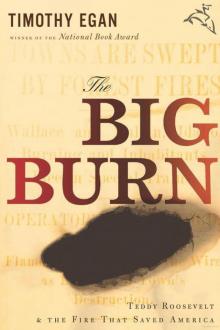 The Big Burn: Teddy Roosevelt and the Fire That Saved America
The Big Burn: Teddy Roosevelt and the Fire That Saved America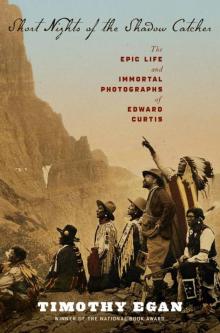 Short Nights of the Shadow Catcher
Short Nights of the Shadow Catcher A Pilgrimage to Eternity
A Pilgrimage to Eternity The Worst Hard Time
The Worst Hard Time The Big Burn
The Big Burn